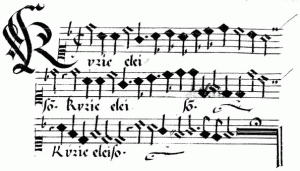![]() Guide: Vocal Music in the Medieval and Renaissance Periods
Guide: Vocal Music in the Medieval and Renaissance Periods
Madrigal was a form of non-religious (secular) Renaissance vocal music for two or more singers, which reached the peak of its popularity in the 16th century. In France, the equivalent form was known as chanson.
Unlike most sacred music of the time, madrigals were composed in the vernacular language (English, French, Italian, etc) rather than Latin. Composers generally used secular poetry as texts, and sometimes utilized word painting (see below) as a notable compositional device.
What to listen for:
- A polyphonic musical texture.
- Madrigal was sung in the vernacular, i.e. the common tongue, rather than Latin.
- The use of word painting (it’s not in every madrigal, but it’s in a lot of them).
- Madrigals are often (though not always) playful, lively, and clever in tone.
Recommended listening:
- As Vesta Was from Latmos Hill Descending, Thomas Weelkes [YouTube] view the score [ChoralWiki] English, 1601. (Not 1501, as the video says.)
This piece a classic and clear example of word painting. Pay special attention to the way the words and phrases “ascending,” “descending,” “running down,” “two by two,” etc, are treated by the composer in this piece! To begin with, I suggest you listen and look at the score to perceive this on your own—but here’s a “cheat sheet” of notable moments.
- Le chant des Oyseaulx, Clement Janequin [YouTube] view the score [IMSLP] French, 1528.
I personally think this chanson (French madrigal) is completely fantastic, and it’s a great example of word painting and musical depiction. In this piece, titled “The Song of the Birds,” the singers imitate bird calls as a musical illustration of the content of the text. (Check out the music 3 minutes in!) Here’s a translation of the French lyrics into English:
Wake up sleeping heads! The God of Love calls you! The birds will work wonders this May Day to dispel your worries. Unplug your ears.
Everyone will be filled with joy, for the season is pleasant, and the song-thrush will make sweet, original music. Everyone will laugh and rejoice. The nightingale sets the woods ringing with twittering throat.
Flee regrets, tears, and cares! The season is pleasant. Away Mister Cuckoo, everyone regards you as a traitor. “Cuckoo” . . . treacherously laying eggs in each nest uninvited. Wake up sleeping heads! The God of Love calls you!
